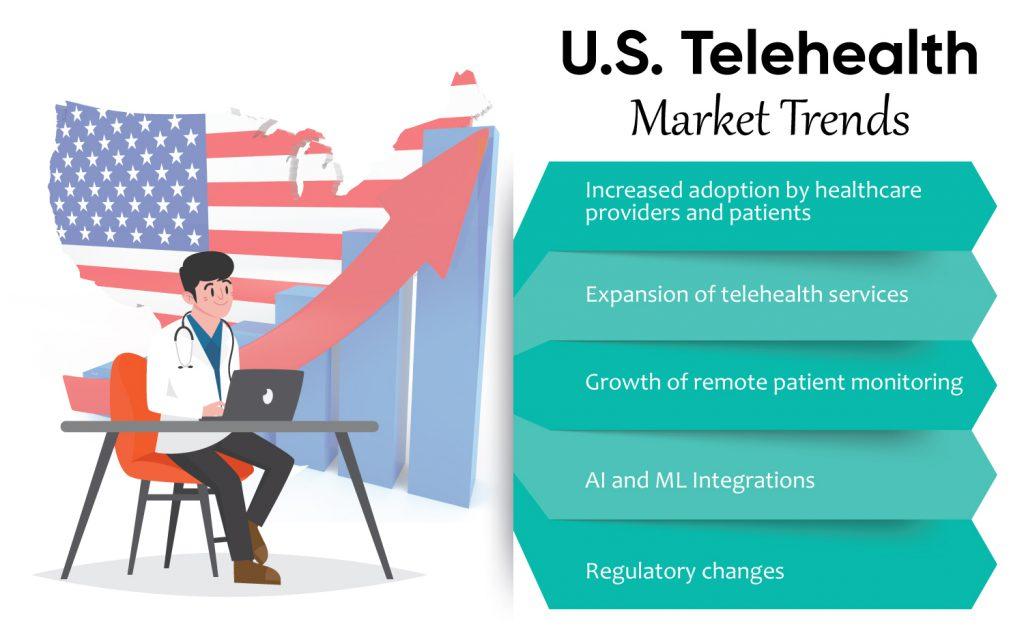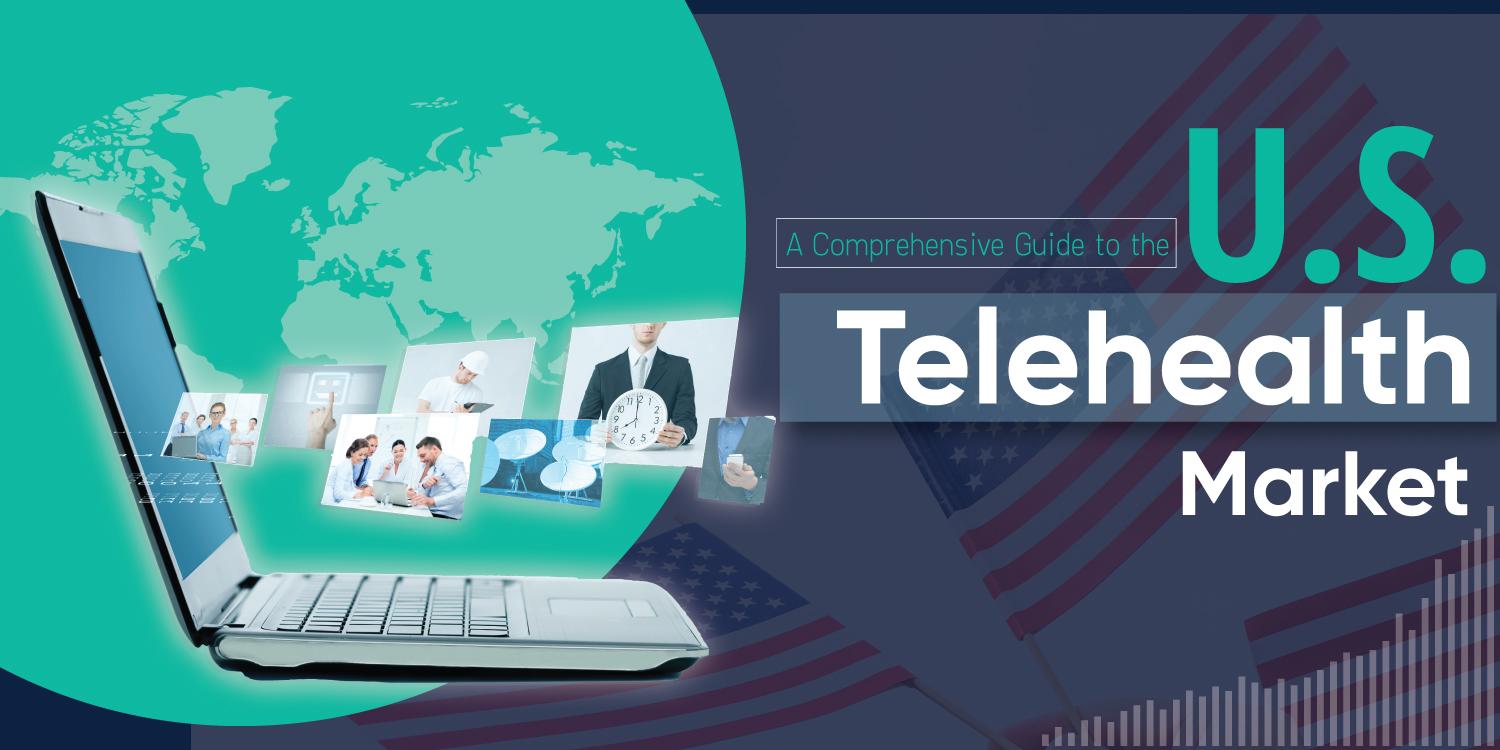A Comprehensive Guide to the U.S. Telehealth Market
Are you looking to tap into the rapidly growing U.S. telehealth market? Do you want to launch telemedicine software for providers? In this comprehensive guide, we’ll explore everything you need to know about the U.S. telehealth market and how to chart a successful path to success.
We’ll discuss why U.S. telehealth care is attractive for businesses and professionals. We’ll look at strategies for navigating the regulatory landscape. We’ll end with some insights from our decades of experience in entrepreneurship and telehealth startups consulting. So let’s get started!
Table of Contents
- The Rapidly Growing U.S. Telehealth Market: Size, Growth, Forecast, and Adoption
- Market Segmentation of U.S. Telehealth
- U.S. Telehealth Market Trends
- Growth Drivers in the United States Telehealth Market
- Advantages of U.S. Telehealth Platforms
- Vital Role Played by White Label Telehealth Solutions in the U.S. Market
- Challenges Faced in the U.S. Telehealth Market
- Launching Your Own HIPAA-compliant Telemedicine Software for Startups
- Conclusion
- FAQ’S
The Rapidly Growing U.S. Telehealth Market: Size, Growth, Forecast, and Adoption
The U.S. telehealth market has grown exponentially over the last few years. It is now valued at nearly $11.5 billion. Over the next few years, the market is expected to reach $55.6 billion with a CAGR of 25.1%.
Factors such as increasing demand for remote patient monitoring, rising healthcare costs, and technological advancements drive the growth in the US telehealth market. We also must take into account the COVID-19 pandemic. It has increased the need for virtual healthcare platform and remote care.
Today many providers and patients have embraced telehealth as a convenient and effective alternative to traditional in-person care. Over 80% of Americans are now willing to use telehealth services platform. Up to $250 billion of current U.S. healthcare spend could be virtualized, indicating significant potential for growth in telehealth adoption.
Market Segmentation of U.S. Telehealth
Segmentation is one key factor when navigating the U.S. telehealth market. By understanding the different segments, you can gain insights into the needs and preferences of various target populations.
Below are several segments of the U.S. Telehealth Market:
- Hospital-Based Telehealth Services Platform: These services are offered by healthcare professionals at hospitals and other facilities.
- Home-Based Telehealth Services Platform: This segment refers to services offered in the comfort of one’s home.
- Remote Patient Monitoring (RPM): RPM is a telehealth service aimed at helping individuals manage their health from afar. This can include monitoring vital signs, providing medication reminders, sending appointment reminders, and more.
- Virtual Doctor Software for Clinics: Virtual clinics provide medical care via teleconferencing platforms like Skype or Zoom.
- Mobile Health Services: Mobile health services allow users to access health care services on their phones or tablets. These services are becoming increasingly popular due to convenience and cost savings for patients.
By understanding each of these segments, you will identify potential opportunities for growth in the U.S. telehealth market.
U.S. Telehealth Market Trends
Telehealth has rapidly gained popularity in USA, especially after the COVID-19 pandemic. The U.S. telehealth market will continue its upward trajectory in the coming years. Here are some key trends to watch:

1. Increased adoption by healthcare providers and patients:
The COVID-19 pandemic has led to a significant increase in the adoption of telehealth services by healthcare providers and patients. This trend is expected to continue as telemedicine solution for patients and providers become more comfortable with the technology and as regulations evolve to support telehealth services.
2. Expansion of telehealth services:
Telehealth services are no longer limited to just virtual consultations with healthcare providers. There has been a significant expansion in telehealth services, including remote patient monitoring, mobile health apps, and telemedicine solutions robots.
3. Growth of remote patient monitoring:
Remote patient monitoring has emerged as a key growth area in telehealth. This technology allows healthcare providers to remotely monitor patient vital signs and health metrics, enabling early intervention and improved outcomes.
4. AI and ML Integrations:
Artificial intelligence and machine learning are increasingly integrated into telehealth services to improve accuracy and efficiency. For example, AI-powered chatbots can help patients navigate their care and provide immediate assistance.
5. Regulatory changes:
Regulatory changes have played a key role in the growth of the telehealth market. For example, the U.S. Centers for Medicare and Medicaid Services (CMS) recently expanded reimbursement for telehealth services, making it easier for patients to access care remotely.
Overall, the U.S. telehealth market is expected to continue its growth trajectory, driven by technological advances, increased adoption by healthcare providers and patients, and supportive regulatory changes.
Growth Drivers in the United States Telehealth Market
Right now, telehealth solutions for patients is on the rise – and understanding the growth drivers in the U.S. market can help you chart your path to success. So what are some of the significant trends that are driving this growth?
Increased demand for convenience
First off, there’s a growing demand for convenience- and telehealth platforms for patients offer comfort and convenience. People want access to healthcare without leaving their homes – whether that’s because they have a disability or an underlying condition or because they’re just busy and don’t feel like dealing with long wait times at the doctor.
Growing acceptance from insurers
More insurance providers are beginning to understand that telehealth is convenient for patients and cost-efficient for payers, too – providing quality care at a lower cost than traditional healthcare services. As more payers come around and recognize the benefit of telehealth, it will become even more widely available in the USA.
Increasing availability of technology
Finally, there’s increasing availability of technology – with more doctors turning to digital medical records systems, connected devices, and other technologies that enable remote monitoring and diagnosis. This makes it easier for physicians and patients alike to make use of telehealth services, which have grown its adoption exponentially over time.
Advantages of U.S. Telehealth Platforms
Telehealth brings a lot of advantages to healthcare in the U.S. compared to traditional models. Let’s take a look at some of the key benefits you can expect from telehealth platforms:
Convenience
The convenience factor is one of the biggest draws. People can connect with clinicians from home and access healthcare services remotely. This eliminates the need for long trips to the doctor’s office and helps overcome logistical issues like transportation and childcare.
Faster care delivery
Telehealth services provide near-instantaneous access to healthcare services. Patients can connect with clinicians in real-time without waiting days or weeks for an appointment or test results. On top of that, they don’t need to travel a long way just to get simple medical advice or services.
Cost savings
Telemedicine software for doctors is cost-effective when compared with traditional models. It eliminates unnecessary clinical visits and expensive diagnostic tests, providing improved access and remote monitoring capabilities that help prevent medical complications.
Improved engagement & satisfaction
With telehealth, patients are more engaged and satisfied with their treatment because they receive prompt medical attention whenever needed—avoiding those pesky waiting rooms! Plus, they have more control over when their appointments occur (and what technology they use).
Overall, telehealth goes far beyond simply replacing face-to-face visits—it enables better disease management, improved communication between providers and patients, and higher quality outcomes in care delivery.
Vital Role Played by White Label Telehealth Solutions in the U.S. Market
White-label telehealth solutions are vital in transforming the U.S. telehealth market. As more and more people become aware of telehealth, the demand for technology-enabled services continues to increase, giving rise to a whole new market.
In most cases, white-label telehealth solutions are software that allows healthcare organizations to offer remote care services with minimum setup effort and cost. These services include virtual visit methods like text, audio, video streaming, online patient portals, remote monitoring, and patient engagement tools.
Benefits of White-Label Telehealth Solutions
White-label telehealth solutions bring many benefits to healthcare organizations, including:
- Compatibility: Most white-label telehealth solutions are compatible with numerous existing healthcare systems and technologies, making it easier for organizations to integrate their existing infrastructure with the new technology.
- Cost-effectiveness: Outsourcing specialized development work through white-label solutions can save healthcare organizations time and money—as well as the hassle of managing multiple vendors— compared to developing custom software from scratch.
- Flexibility: White-label solutions can also be customized and adapted quickly to meet changing digital healthcare technology needs and improve the user experience for patients and clinicians alike.
Overall, white-label telehealth solutions offer a way for healthcare providers to quickly get up-to-speed on digital healthcare technologies while maintaining control over the quality of service they provide their patients.
Challenges Faced in the U.S. Telehealth Market
Breaking into the U.S. telehealth market can be tricky, with several challenges you must know. Let’s look at some of the biggest challenges you may face to get your telehealth project up and running.
Reimbursement
Healthcare facilities must understand the specific rules and regulations that apply to their region. Insurers in some areas may not cover any or all of the costs associated with telemedicine services, which can play a significant role in the viability of a project.
Workflow Integration
Integrating telehealth services into the existing workflow can take time due to regulatory and organizational hurdles. Healthcare providers must ensure that their systems are secure and compliant with regulations regarding the privacy and security of personal health information (PHI) before launching telehealth initiatives.
Training
Training staff on Telemedicine technology is an often-overlooked challenge when launching new projects. With technology changing constantly, healthcare providers must ensure that staff can use new tools quickly and efficiently to maximize efficiency and limit potential disruption in patient care.
Launching Your Own HIPAA-compliant Telemedicine Software for Startups
Do you want to launch a telehealth startup? We have the perfect solutions that if fully white-label and HIPAA compliant. Our solution comes packed with features that make patient care and monitoring seamless.
For more details on our telehealth startup program, book a meeting with one of our experts now!
Custom Telehealth Solution Just 4 U. Contact Now!
Conclusion
When we think of telehealth platforms for providers and patients in the USA, the opportunities are endless. The market is growing at an exponential rate. And the benefits are for all stakeholders involved- patients, providers, and telehealth startups.
Of course, there are bumps in the road! The US government is very strict on patient data security and privacy. And telehealth solutions have to be just that extra careful to ensure there are no loopholes whatsoever.
If you are looking for a telehealth solution for clinics and hospitals that meets all regulatory standards, is easy to use, and fully white label-look no further than VCDoctor.
Choose VCDoctor telemedicine software for doctors and watch your patient engagement soar, your efficiency skyrocket, and your practice thrive in the ever-changing world of healthcare. Telehealth is the future, connecting doctors and patients for better health, all around. Ready to join the revolution?
FAQ’S
- How has the U.S. telehealth market evolved over the years?
The U.S. telehealth market has evolved from basic video conferencing to a wide range of virtual healthcare services over the years, which includes live video consultations, remote patient monitoring, and mobile health applications.
- What is the U.S. telehealth market size?
The U.S. telehealth market is projected to reach USD 307.7 billion by 2028, growing at a CAGR of nearly 45% from 2022 to 2028.
- What are some key U.S. telehealth market trends?
The key trends in the U.S. telehealth market include increased adoption of virtual care, expansion of telehealth services beyond traditional healthcare settings, growth in remote monitoring and wearable technology, and a greater focus on mental health and behavioural telehealth.
- What are some key U.S. telehealth market challenges?
Challenges faced by the U.S. telehealth market include reimbursement policies, regulatory barriers, and the need for infrastructure investment.
- What about reimbursement policies?
Telehealth Reimbursement policies in the U.S. market vary by payer, but most private insurers and Medicare cover certain telehealth services.
- How can patients find and access telehealth services in the U.S. market?
Patients can find and access telehealth services in the U.S. market through online platforms, healthcare providers, and telehealth companies.




